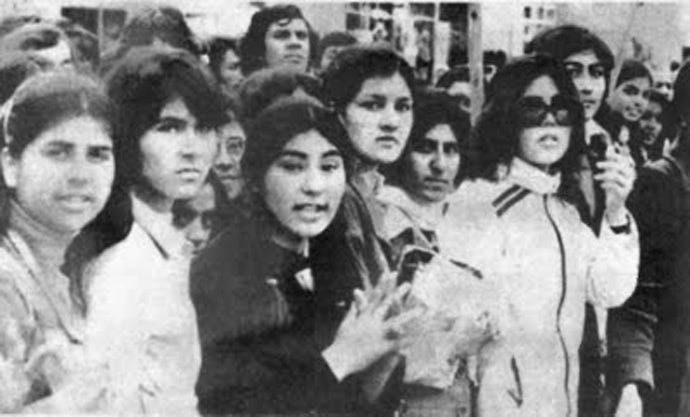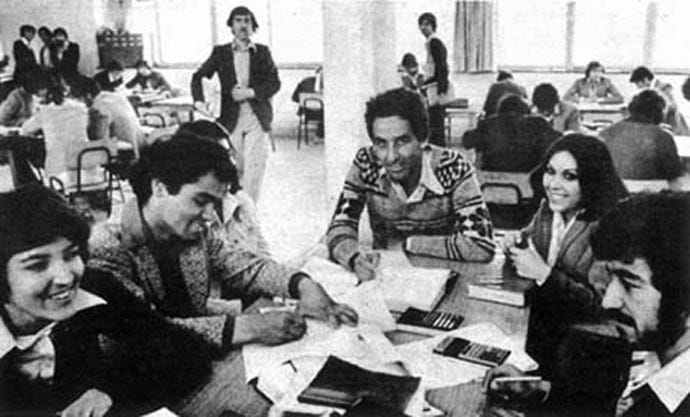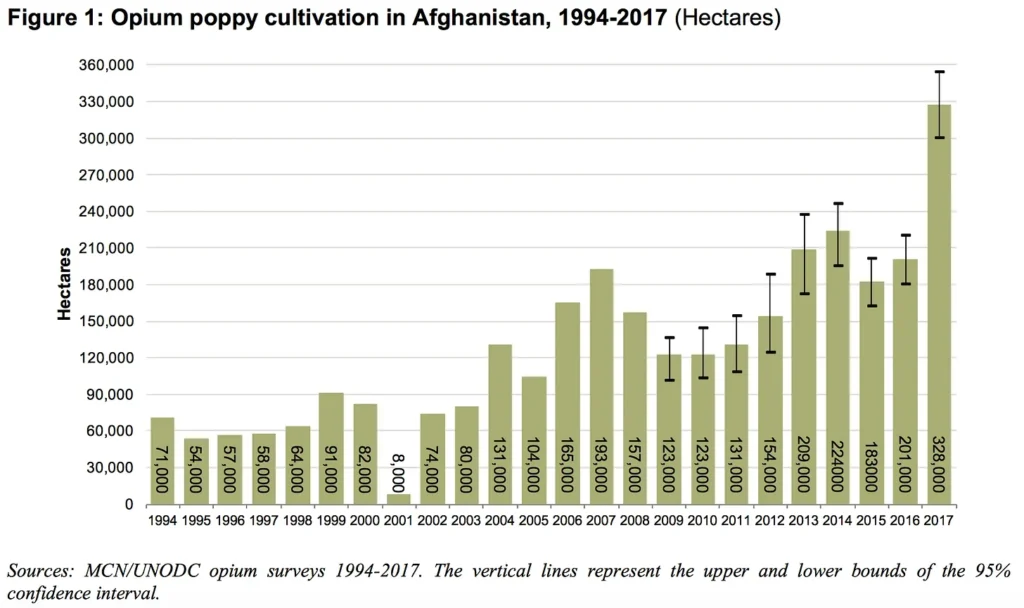“The War Worth Waging”: Afghanistan’s Vast Reserves of Minerals and Natural Gas
WAR RACKET--CATASTROPHE CAPITALISM, 11 Sep 2023
Michel Chossudovsky | Substack - TRANSCEND Media Service
The War on Afghanistan Is a Profit-driven “Resource War”
6 Sep 2023 – US-NATO forces invaded Afghanistan more than 20 years ago on October 7, 2001. It’s been a continuous war marked by US military occupation.
In the wake of the withdrawal of US troops, Afghanistan’s assets were confiscated:
“Exactly a year after the Taliban seized control of Afghanistan’s government, the Biden administration said it would not return any of the $7 billion in Afghan central bank assets that it commandeered earlier this year, despite pleas from both human rights groups and economists to help pull the impoverished country out of its economic crisis.”
A once prosperous country has been precipitated into extreme poverty and despair. It’s a crime against humanity.
According to the UN, Afghanistan is currently experiencing extensive food shortages and famine.
It should be understood that this war started more than 40 years ago in 1979 with the CIA recruitment of jihadist mercenaries (Al Qaeda) funded by the trade in narcotics.
The endgame was to destroy Afghanistan as a progressive and independent nation state committed to education, culture and women’s rights.
Unknown to Americans, in the 1970s and early 1980s, Kabul was “a cosmopolitan city. Artists and hippies flocked to the capital. Women studied agriculture, engineering and business at the city’s university. Afghan women held government jobs.”


Images: Kabul University early 1980s
All of this was destroyed by continuous US-NATO and CIA interventions going back to 1979. It is a criminal undertaking, it’s the destruction of an entire country.
And today at the time of writing [September 2023], the October 2001 war on Afghanistan continues to be heralded as a humanitarian endeavour, a “Just War” in retribution for the 9/11 attacks against the American people. What utter nonsense!
The legal argument used by Washington and NATO to invade and occupy Afghanistan under “the doctrine of collective security” (Article 5 of the Washington Treaty) was that the September 11 2001 attacks constituted an undeclared “armed attack” “from abroad” by an unnamed foreign power, namely Afghanistan.
Yet there were no Afghan fighter planes in the skies of New York on the morning of September 11, 2001. Ironically, Osama bin Laden who had been recruited by the CIA is the early 1980s was held responsible for the 9/11 attacks.
The article below, first published in June 2010, points to the “real economic reasons” underlying the US-NATO invasion of Afghanistan four weeks after the September 11, 2001 attacks.
There are geopolitical and strategic dimensions as well as an economic agenda. In addition to its vast mineral and gas reserves including lithium as well as iron, copper, cobalt and gold, Afghanistan produces more than 80 percent of the World’s supply of opium which is used to produce grade 4 heroin, morphine as well as pharmaceutical opioids.
Despite the “formal withdrawal” of US troops in late August 2021, Washington is intent upon retaining its control over the multibillion narcotics trade. See below:
Opium 2016
Washington is also intent upon blocking Afghanistan’s relationship with China and its Belt and Road Initiative.
The balance of power has shifted.
The geopolitics has changed dramatically since the official withdrawal of US troops in August 2021.
Will the U.S. be able to exert and maintain its control over the Taliban government? Will it be able to maintain its control over the multibillion dollar trade in opioids?
China for several years has been playing a key strategic role in the development of Afghanistan’s vast mineral resources as well as its transport infrastructure.
A highway linking Afghanistan’s North-East Badakhshan province via the historic “Wakhan Corridor” to China’s Xinjiang Province (Uyghur Autonomous Region) is contemplated.
— Michel Chossudovsky, 3 Sep 2023
**********************************
“The War Is Worth Waging”: Afghanistan’s Vast Reserves of Minerals and Natural Gas
The War on Afghanistan Is a Profit-driven “Resource War”
October 2010
The 2001 bombing and invasion of Afghanistan has been presented to World public opinion as a “Just War”, a war directed against the Taliban and Al Qaeda, a war to eliminate “Islamic terrorism” and instate Western style democracy.
The economic dimensions of the “Global War on Terrorism” (GWOT) are rarely mentioned. The post 9/11 “counter-terrorism campaign” has served to obfuscate the real objectives of the US-NATO war.
The war on Afghanistan is part of a profit driven agenda: a war of economic conquest and plunder, “a resource war”.
While Afghanistan is acknowledged as a strategic hub in Central Asia, bordering on the former Soviet Union, China and Iran, at the crossroads of pipeline routes and major oil and gas reserves, its huge mineral wealth as well as its untapped natural gas reserves have remained, until June 2010, totally unknown to the American public.
According to a joint report by the Pentagon, the US Geological Survey (USGS) and USAID, Afghanistan is now said to possess “previously unknown” and untapped mineral reserves, estimated authoritatively to be of the order of one trillion dollars (New York Times, U.S. Identifies Vast Mineral Riches in Afghanistan – NYTimes.com, June 14, 2010, See also BBC, 14 June 2010).
“The previously unknown deposits — including huge veins of iron, copper, cobalt, gold and critical industrial metals like lithium — are so big and include so many minerals that are essential to modern industry that Afghanistan could eventually be transformed into one of the most important mining centers in the world, the United States officials believe.
An internal Pentagon memo, for example, states that Afghanistan could become the “Saudi Arabia of lithium,” a key raw material in the manufacture of batteries for laptops and BlackBerrys.
The vast scale of Afghanistan’s mineral wealth was discovered by a small team of Pentagon officials and American geologists. The Afghan government and President Hamid Karzai were recently briefed, American officials said.
While it could take many years to develop a mining industry, the potential is so great that officials and executives in the industry believe it could attract heavy investment even before mines are profitable, providing the possibility of jobs that could distract from generations of war.
“There is stunning potential here,” Gen. David H. Petraeus, commander of the United States Central Command, said… “There are a lot of ifs, of course, but I think potentially it is hugely significant.”
The value of the newly discovered mineral deposits dwarfs the size of Afghanistan’s existing war-bedraggled economy, which is based largely on opium production and narcotics trafficking as well as aid from the United States and other industrialized countries. Afghanistan’s gross domestic product is only about $12 billion.
“This will become the backbone of the Afghan economy,” said Jalil Jumriany, an adviser to the Afghan minister of mines. (New York Times,op. cit.)
Afghanistan could become, according to The New York Times “the Saudi Arabia of lithium”.
“Lithium is an increasingly vital resource, used in batteries for everything from mobile phones to laptops and key to the future of the electric car.”
At present Chile, Australia, China and Argentina are the main suppliers of lithium to the world market.
Bolivia and Chile are the countries with the largest known reserves of lithium. The Pentagon has been conducting ground surveys in western Afghanistan.
“Pentagon officials said that their initial analysis at one location in Ghazni province showed the potential for lithium deposits as large as those of Bolivia” (U.S. Identifies Vast Mineral Riches in Afghanistan – NYTimes.com, June 14, 2010, see also Lithium – Wikipedia, the free encyclopedia)
“Previously Unknown Deposits” of Minerals in Afghanistan
The Pentagon’s near one trillion dollar “estimate” of previously “unknown deposits” is a useful smokescreen. The Pentagon one trillion dollar figure is more a trumped up number rather than an estimate: “We took a look at what we knew to be there, and asked what would it be worth now in terms of today’s dollars. The trillion dollar figure seemed to be newsworthy.” (The Sunday Times, London, June 15 2010, emphasis added)
Moreover, the results of a US Geological Survey study (quoted in the Pentagon memo) on Afghanistan’s mineral wealth were revealed three years back, at a 2007 Conference organized by the Afghan-American Chamber of Commerce. The matter of Afghanistan’s mineral riches, however, was not considered newsworthy at the time.
The US Administration’s acknowledgment that it first took cognizance of Afghanistan’s vast mineral wealth following the release of the USGS 2007 report is an obvious red herring. Afghanistan’s mineral wealth and energy resources (including natural gas) were known to both America’s business elites and the US government prior to the US sponsored “Soviet-Afghan war” (1979-1988).
Geological surveys conducted by the Soviet Union in the 1970s and early 1980s confirm the existence of vast reserves of copper (among the largest in Eurasia), iron, high grade chrome ore, uranium, beryl, barite, lead, zinc, fluorspar, bauxite, lithium, tantalum, emeralds, gold and silver.(Afghanistan, Mining Annual Review, The Mining Journal, June, 1984).
These surveys suggest that the actual value of these reserves could indeed be substantially larger than the one trillion dollars “estimate” intimated by the Pentagon-USCG-USAID study.
More recently, in a 2002 report, the Kremlin confirmed what was already known: “It’s no secret that Afghanistan possesses rich reserves, in particular of copper at the Aynak deposit, iron ore in Khojagek, uranium, polymetalic ore, oil and gas,” (RIA Novosti, January 6, 2002):
“Afghanistan has never been anyone’s colony – no foreigner had ever “dug” here before the 1950s. The Hindu Kush mountains, stretching, together with their foothills, over a vast area in Afghanistan, are where the minerals lie. Over the past 40 years, several dozen deposits have been discovered in Afghanistan, and most of these discoveries were sensational. They were kept secret, however, but even so certain facts have recently become known.
It turns out that Afghanistan possesses reserves of nonferrous and ferrous metals and precious stones, and, if exploited, they would possibly be able to cover even the earnings from the drug industry. The copper deposit in Aynak in the southern Afghan Helmand Province is said to be the largest in the Eurasian continent, and its location (40 km from Kabul) makes it cheap to develop. The iron ore deposit at Hajigak in the central Bamian Province yields ore of an extraordinarily high quality, the reserves of which are estimated to be 500m tonnes. A coal deposit has also been discovered not far from there.
Afghanistan is spoken of as a transit country for oil and gas. However, only a very few people know that Soviet specialists discovered huge gas reserves there in the 1960s and built the first gas pipeline in the country to supply gas to Uzbekistan. At that time, the Soviet Union used to receive 2.5 bn cubic metres of Afghan gas annually. During the same period, large deposits of gold, fluorite, barytes and marble onyxes that have a very rare pattern were found.
However, the pegmatite fields discovered to the east of Kabul are a real sensation. Rubies, beryllium, emeralds and kunzites and hiddenites that cannot be found anywhere else – the deposits of these precious stones stretch for hundreds of kilometres. Also, the rocks containing the rare metals beryllium, thorium, lithium and tantalum are of strategic importance (they are used in air and spacecraft construction).
The war is worth waging. … (Olga Borisova, “Afghanistan – the Emerald Country”, Karavan, Almaty, original Russian, translated by BBC News Services, Apr 26, 2002. p. 10, emphasis added.)
While public opinion was fed images of a war torn resourceless developing country, the realities are otherwise: Afghanstan is a rich country as confirmed by Soviet era geological surveys.
The issue of “previously unknown deposits” sustains a falsehood. It excludes Afghanstan’s vast mineral wealth as a justifiable casus belli. It says that the Pentagon only recently became aware that Afghanistan was among the World’s most wealthy mineral economies, comparable to The Democratic Republic of the Congo or former Zaire of the Mobutu era. The Soviet geopolitical reports were known. During the Cold War, all this information was known in minute detail:
… Extensive Soviet exploration produced superb geological maps and reports that listed more than 1,400 mineral outcroppings, along with about 70 commercially viable deposits … The Soviet Union subsequently committed more than $650 million for resource exploration and development in Afghanistan, with proposed projects including an oil refinery capable of producing a half-million tons per annum, as well as a smelting complex for the Ainak deposit that was to have produced 1.5 million tons of copper per year. In the wake of the Soviet withdrawal a subsequent World Bank analysis projected that the Ainak copper production alone could eventually capture as much as 2 percent of the annual world market. The country is also blessed with massive coal deposits, one of which, the Hajigak iron deposit, in the Hindu Kush mountain range west of Kabul, is assessed as one of the largest high-grade deposits in the world. (John C. K. Daly, Analysis: Afghanistan’s untapped energy, UPI Energy, October 24, 2008, emphasis added)
Afghanistan’s Natural Gas
Afghanistan is a land bridge. The 2001 U.S. led invasion and occupation of Afghanistan has been analysed by critics of US foreign policy as a means to securing control over the strategic trans-Afghan transport corridor which links the Caspian sea basin to the Arabian sea.
Several trans-Afghan oil and gas pipeline projects have been contemplated including the planned $8.0 billion TAPI pipeline project (Turkmenistan, Afghanistan, Pakistan, India) of 1900 km., which would transport Turkmen natural gas across Afghanistan in what is described as a “crucial transit corridor”. (See Gary Olson, Afghanistan has never been the ‘good and necessary’ war; it’s about control of oil, The Morning Call, October 1, 2009).
Military escalation under the extended Af-Pak war bears a relationship to TAPI. Turkmenistan possesses third largest natural gas reserves after Russia and Iran. Strategic control over the transport routes out of Turkmenistan have been part of Washington’s agenda since the collapse of the Soviet union in 1991.
What was rarely contemplated in pipeline geopolitics, however, is that Afghanistan is not only adjacent to countries which are rich in oil and natural gas (e.g Turkmenistan), it also possesses within its territory sizeable untapped reserves of natural gas, coal and oil. Soviet estimates of the 1970s placed “Afghanistan’s ‘explored’ (proved plus probable) gas reserves at about 5 trillion cubic feet. The Hodja-Gugerdag’s initial reserves were placed at slightly more than 2 tcf.” (See, The Soviet Union to retain influence in Afghanistan, Oil & Gas Journal, May 2, 1988).
The U.S. Energy Information Administration (EIA) acknowledged in 2008 that Afghanistan’s natural gas reserves are “substantial”:
“As northern Afghanistan is a ‘southward extension of Central Asia’s highly prolific, natural gas-prone Amu Darya Basin,’ Afghanistan ‘has proven, probable and possible natural gas reserves of about 5 trillion cubic feet.’ (UPI, John C.K. Daly, Analysis: Afghanistan’s untapped energy, October 24, 2008)
From the outset of the Soviet-Afghan war in 1979, Washington’s objective has been to sustain a geopolitical foothold in Central Asia.
The Golden Crescent Drug Trade
America’s covert war, namely its support to the Mujahideen “Freedom fighters” (aka Al Qaeda) was also geared towards the development of the Golden Crescent trade in opiates, which was used by US intelligence to fund the insurgency directed against the Soviets.1
Instated at the outset of the Soviet-Afghan war and protected by the CIA, the drug trade developed over the years into a highly lucrative multibillion undertaking. It was the cornerstone of America’s covert war in the 1980s. Today, under US-NATO military occupation, the drug trade generates cash earnings in Western markets in excess of $200 billion dollars a year. (See Michel Chossudovsky, America’s War on Terrorism, Global Research, Montreal, 2005, see also Michel Chossudovsky, Heroin is “Good for Your Health”: Occupation Forces support Afghan Narcotics Trade, Global Research, April 29, 2007)
Towards an Economy of Plunder
The US media, in chorus, has upheld the “recent discovery” of Afghanistan’s mineral wealth as “a solution” to the development of the country’s war torn economy as well as a means to eliminating poverty. The 2001 US-NATO invasion and occupation has set the stage for their appropriation by Western mining and energy conglomerates.
The war on Afghanistan is a profit driven “resource war”.
Under US and allied occupation, this mineral wealth is slated to be plundered, once the country has been pacified, by a handful of multinational mining conglomerates. According to Olga Borisova, writing in the months following the October 2001 invasion, the US-led “war on terrorism [will be transformed] into a colonial policy of influencing a fabulously wealthy country.” (Borisova, op cit).
Part of the US-NATO agenda is also to eventually take possession of Afghanistan’s reserves of natural gas, as well as prevent the development of competing Russian, Iranian and Chinese energy interests in Afghanistan.
NOTE:
1. The Golden Crescent trade in opiates constitutes, at present, the centerpiece of Afghanistan’s export economy. The heroin trade, instated at the outset of the Soviet-Afghan war in 1979 and protected by the CIA, generates cash earnings in Western markets in excess of $200 billion dollars a year. Since the 2001 invasion, narcotics production in Afghanistan has increased more than 35 times. In 2009, opium production stood at 6900 tons, compared to less than 200 tons in 2001. In this regard, the multibillion dollar earnings resulting from the Afghan opium production largely occur outside Afghanistan. According to United Nations data, the revenues of the drug trade accruing to the local economy are of the order of 2-3 billion annually. In contrast with the Worldwide sales of heroin resulting from the trade in Afghan opiates, in excess of $200 billion. (See Michel Chossudovsky, America’s War on Terrorism”, Global Research, Montreal, 2005)
_________________________________________
 Michel Chossudovsky is an award-winning author, Professor of Economics (emeritus) at the University of Ottawa, Founder and Director of the Centre for Research on Globalization (CRG), Montreal, Editor of Global Research. He has taught as visiting professor in Western Europe, Southeast Asia, the Pacific and Latin America. He has served as economic adviser to governments of developing countries and has acted as a consultant for several international organizations. He is the author of eleven books including The Globalization of Poverty and The New World Order (2003), America’s “War on Terrorism” (2005), The Global Economic Crisis, The Great Depression of the Twenty-first Century (2009) (Editor), Towards a World War III Scenario: The Dangers of Nuclear War (2011), The Globalization of War, America’s Long War against Humanity (2015). He is a contributor to the Encyclopaedia Britannica. His writings have been published in more than twenty languages. In 2014, he was awarded the Gold Medal for Merit of the Republic of Serbia for his writings on NATO’s war of aggression against Yugoslavia. He can be reached at crgeditor@yahoo.com
Michel Chossudovsky is an award-winning author, Professor of Economics (emeritus) at the University of Ottawa, Founder and Director of the Centre for Research on Globalization (CRG), Montreal, Editor of Global Research. He has taught as visiting professor in Western Europe, Southeast Asia, the Pacific and Latin America. He has served as economic adviser to governments of developing countries and has acted as a consultant for several international organizations. He is the author of eleven books including The Globalization of Poverty and The New World Order (2003), America’s “War on Terrorism” (2005), The Global Economic Crisis, The Great Depression of the Twenty-first Century (2009) (Editor), Towards a World War III Scenario: The Dangers of Nuclear War (2011), The Globalization of War, America’s Long War against Humanity (2015). He is a contributor to the Encyclopaedia Britannica. His writings have been published in more than twenty languages. In 2014, he was awarded the Gold Medal for Merit of the Republic of Serbia for his writings on NATO’s war of aggression against Yugoslavia. He can be reached at crgeditor@yahoo.com
Go to Original – michelchossudovsky.substack.com
Tags: 9/11, Afghanistan, Capitalism, Hegemony, Imperialism, NATO, Pentagon, State Terrorism, USA, War of Terror, War on Terror, Warfare
DISCLAIMER: The statements, views and opinions expressed in pieces republished here are solely those of the authors and do not necessarily represent those of TMS. In accordance with title 17 U.S.C. section 107, this material is distributed without profit to those who have expressed a prior interest in receiving the included information for research and educational purposes. TMS has no affiliation whatsoever with the originator of this article nor is TMS endorsed or sponsored by the originator. “GO TO ORIGINAL” links are provided as a convenience to our readers and allow for verification of authenticity. However, as originating pages are often updated by their originating host sites, the versions posted may not match the versions our readers view when clicking the “GO TO ORIGINAL” links. This site contains copyrighted material the use of which has not always been specifically authorized by the copyright owner. We are making such material available in our efforts to advance understanding of environmental, political, human rights, economic, democracy, scientific, and social justice issues, etc. We believe this constitutes a ‘fair use’ of any such copyrighted material as provided for in section 107 of the US Copyright Law. In accordance with Title 17 U.S.C. Section 107, the material on this site is distributed without profit to those who have expressed a prior interest in receiving the included information for research and educational purposes. For more information go to: http://www.law.cornell.edu/uscode/17/107.shtml. If you wish to use copyrighted material from this site for purposes of your own that go beyond ‘fair use’, you must obtain permission from the copyright owner.
Read more
Click here to go to the current weekly digest or pick another article:
WAR RACKET--CATASTROPHE CAPITALISM:
